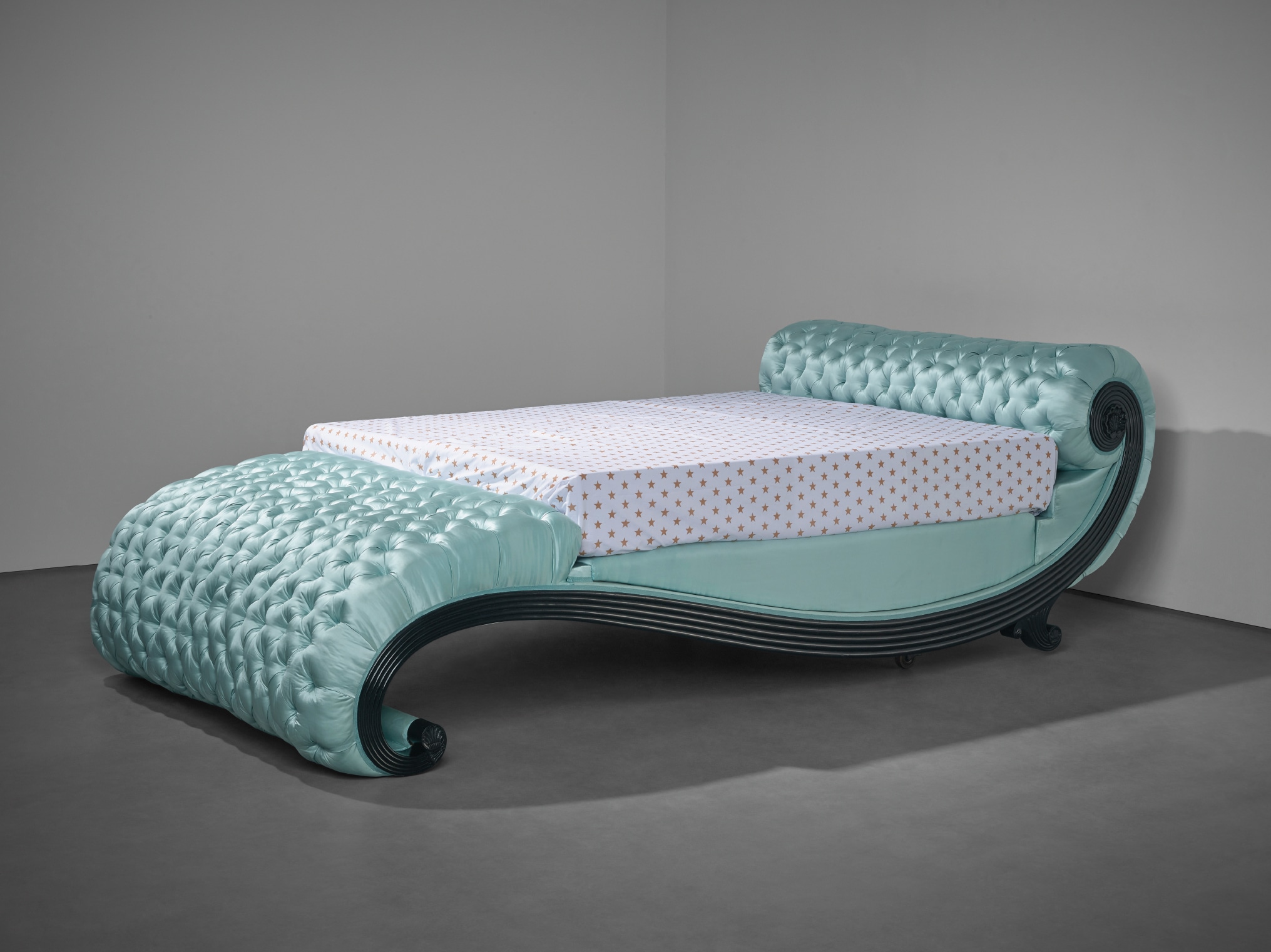

32
Edward James and Norris Wakefield
Important and unique bed, designed for the Map Room, Monkton House, West Sussex
circa 1935
Ebony, fabric.
101 x 160 x 326 cm (39 3/4 x 62 7/8 x 128 3/8 in.)
Full-Cataloguing
Inherent to Edward James, the English poet and passionate supporter of Surrealist art, is his imagination and propensity for collaboration, which enabled James to circumvent the conventions of the world around him. In 1935 James had become closely acquainted with Salvador Dalí, subsequently inviting the artist and his wife Gala Éluard Dalí to visit him in England. Together, James and Dalí discussed the creation of a three-dimensional form of Surrealism, which they sought to realise through everyday objects, interiors and finally entire buildings. The collaboration between James and Dalí during this period produced iconic Surrealist designs including both the Mae West Lips Sofa and the Lobster Telephone, which James commissioned for his residences at 35 Wimpole Street in London and at Monkton House in Sussex. That autumn James and Dalí began discussions with the architect Christopher ‘Kit’ Nicholson and his then associate Hugh Casson to transform Monkton House into a complete Surrealist environment.
Designed in 1902 by the renowned English architect Sir Edwin Lutyens, James’ father had originally built Monkton House on the family’s country estate at West Dean as a retreat from the grandeur of the primary residence, West Dean House. Having inherited the estate, along with a large family fortune, following his father’s death, James reimagined Lutyen’s original Arts and Crafts building to create his own fanciful and extraordinary escape hidden within the beech woods of the English countryside. James worked closely with Nicholson and Casson to dramatically alter the façade: playfully appropriating the form of a classical column, the central entrance was flanked by large ‘palm trees’, whilst the drainpipes were transformed to resemble bamboo, and swags added to the second story windows. Dalí’s contribution to the exterior was the suggestion to cover the building’s vernacular brick walls in shocking purple-coloured stucco.
James realised Monkton House’s theatrical interiors with the London-based decorator Norris Wakefield. The extravagant furnishings featured a mixture of styles, including Regency and custom-designed furniture and an inventive use of textiles. The walls in the hallways were covered in wave-patterned silk and the drawing room walls in a luxurious diamond-quilted fabric. The surrealist interest in natural imagery and forms also featured in many of the designs at Monkton. The influence of the sea is seen throughout James’ interiors, including the fish-themed bathroom and an Italian grotto chair in the drawing room of Monkton House, and the monumental carpet illustrating the Triumph of Neptune designed by Rex Whistler for his vast dining room at Wimpole Street.
Exemplifying the deeply idiosyncratic nature of Monkton house was the so-called Map Room, for which the present lot was designed by James and Wakefield. The bed features a reeded ebony, scroll-shaped frame, terminating with a carved shell – a motif repeated in the pattern of the room’s ornate curtains – and covered in quilted blue silk upholstery. Fulfilling James desire to gaze up at the sky from the grand bed, the central ceiling panel was replaced with backlit glass decorated with stars, supposedly positioned to represent the moment of James’ birth. The Map Room, for which the present bed formed the centre piece, evokes the fantastical and the uncanny nature of Monkton House, an expression of James’ imaginative vision.
Designed in 1902 by the renowned English architect Sir Edwin Lutyens, James’ father had originally built Monkton House on the family’s country estate at West Dean as a retreat from the grandeur of the primary residence, West Dean House. Having inherited the estate, along with a large family fortune, following his father’s death, James reimagined Lutyen’s original Arts and Crafts building to create his own fanciful and extraordinary escape hidden within the beech woods of the English countryside. James worked closely with Nicholson and Casson to dramatically alter the façade: playfully appropriating the form of a classical column, the central entrance was flanked by large ‘palm trees’, whilst the drainpipes were transformed to resemble bamboo, and swags added to the second story windows. Dalí’s contribution to the exterior was the suggestion to cover the building’s vernacular brick walls in shocking purple-coloured stucco.
James realised Monkton House’s theatrical interiors with the London-based decorator Norris Wakefield. The extravagant furnishings featured a mixture of styles, including Regency and custom-designed furniture and an inventive use of textiles. The walls in the hallways were covered in wave-patterned silk and the drawing room walls in a luxurious diamond-quilted fabric. The surrealist interest in natural imagery and forms also featured in many of the designs at Monkton. The influence of the sea is seen throughout James’ interiors, including the fish-themed bathroom and an Italian grotto chair in the drawing room of Monkton House, and the monumental carpet illustrating the Triumph of Neptune designed by Rex Whistler for his vast dining room at Wimpole Street.
Exemplifying the deeply idiosyncratic nature of Monkton house was the so-called Map Room, for which the present lot was designed by James and Wakefield. The bed features a reeded ebony, scroll-shaped frame, terminating with a carved shell – a motif repeated in the pattern of the room’s ornate curtains – and covered in quilted blue silk upholstery. Fulfilling James desire to gaze up at the sky from the grand bed, the central ceiling panel was replaced with backlit glass decorated with stars, supposedly positioned to represent the moment of James’ birth. The Map Room, for which the present bed formed the centre piece, evokes the fantastical and the uncanny nature of Monkton House, an expression of James’ imaginative vision.